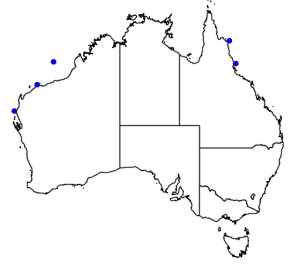
©Anne Hoggett: Distal arm of Phanogenia gracilis at Watson's Bay, Lizard Island. Arms are very fine with widely-spaced, fine pinnules that are oriented at different angles in a repeating pattern along the arm.

©Lyle Vail: Underside of Phanogenia gracilis showing the distinctive small centrodorsal plate surrounded by large radial plates and no cirri. The brittlestar is Ophiomaza cacaotica. Off Crystal Beach, Lizard Island.
Colours
Distinguishing features
Comatulids are distinguised from all other featherstar families by having terminal segments of the oral pinnules modified to form a comb. Comatlids also have a distinctive "feel" due to well developed hooks on most pinnules that cause them to cling like velcro. This species and its congeners, Phanogenia typica and Phanogenia multibrachiata, are the most delicate and "clingy" of the comaulids. Even a gentle brush against the arm tips will cause them to cling and break.
Phanogenia gracilis has 60 to 120 very fine arms, a small centrodorsal plate and no cirri. The central body is partly or completely hidden within the reef during the day.
Two morphotypes of P. gracilis were outlined by Messing (1998). These were investigated by Owen et al (2009) who found that there may be three cryptic species involved that do not conform to the morphotypes. Summers et al (2017) found three genetic clades of Phanogenia without cirri, all morphologically indistinguishable: Phanogenia typica and two clades within Phanogenia gracilis. It is possible that more than one clade exists at Lizard Island.
Colour and colour pattern vary widely within this species. It often comprises small, unordered patches of two or three colours but it may be a single solid colour with or without contrasting pinnule tips. Yellow and black is a common colour combination. Another common colour form is solid grey with orange pinnule tips.
Size
- Size data has not been obtained.
Depth range
- Depth range data is not yet available.
Synonyms
Similar taxa
-
Animalia:
species: Phanogenia multibrachiata
has a good ring of cirri and is always deep red/burgundy sometimes with white flecks. -
Animalia:
species: Phanogenia typica
is indistinguishable morphologically from P. gracilis.
Distribution
Distribution and habitat preferences
Central body concealed within the reef and a bush of fine arms exposed.
Common around the perimeter of the island group and in the entrance channel to the lagoon. It is found less frequently within the lagoon.
Web resources
References
References that assist with identification
- Clark, A.M. and F.W.E. Rowe (1971). Monograph of shallow-water Indo-west Pacific echinoderms British Museum (Natural History), London.
- Owen, C.L., C.G. Messing, G.W. Rouse and M.S. Shivji (2009). Using a combined approach to explain the morphological and ecological diversity in Phanogenia gracilis Hartlaub, 1893 (Echinodermata: Crinoidea) sensu lato: two species or intraspecific variation? Marine Biology, 156: 1517-1529. LIRS catalog number 1257.
- Summers, M.M., C.G. Messing and G.W. Rouse (2017). The genera and species of Comatulidae (Comatulida: Crinoidea): taxonomic revisions and a molecular and morphological guide. Zootaxa, 4268(2): 151-190. LIRS catalog number 2197.
- View all references








